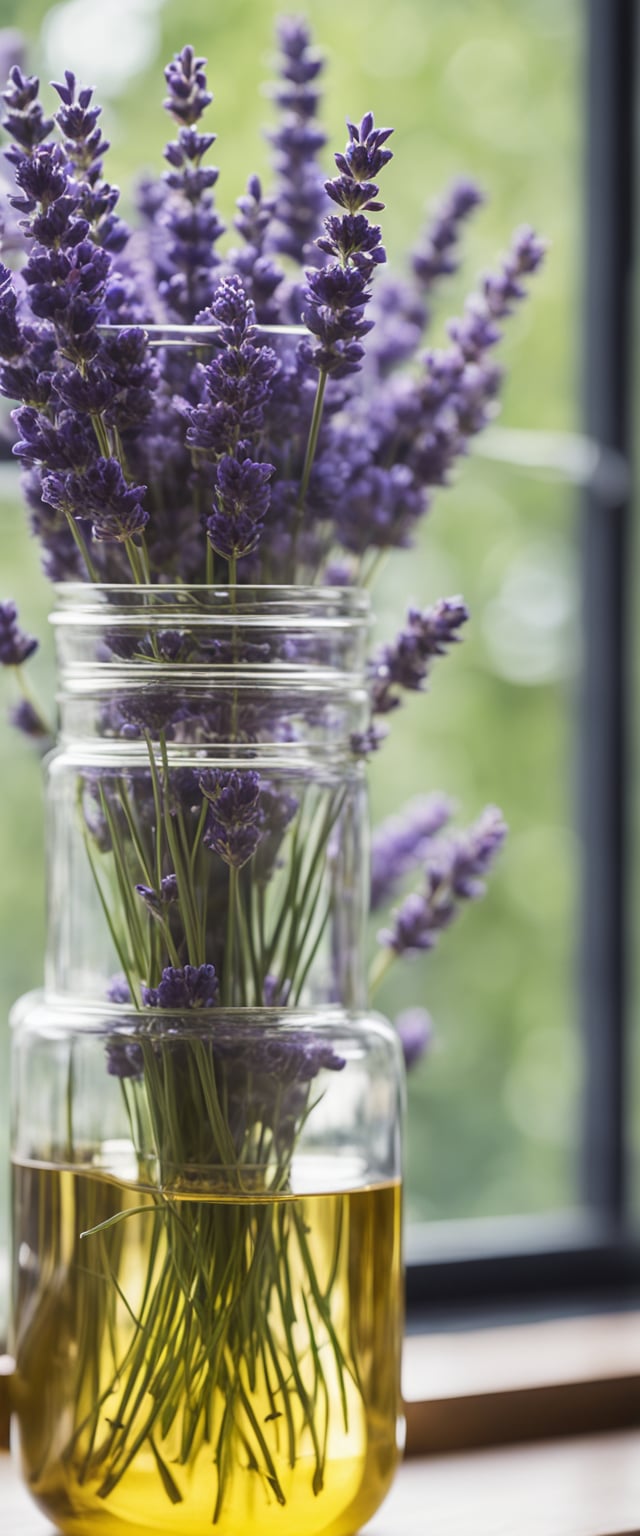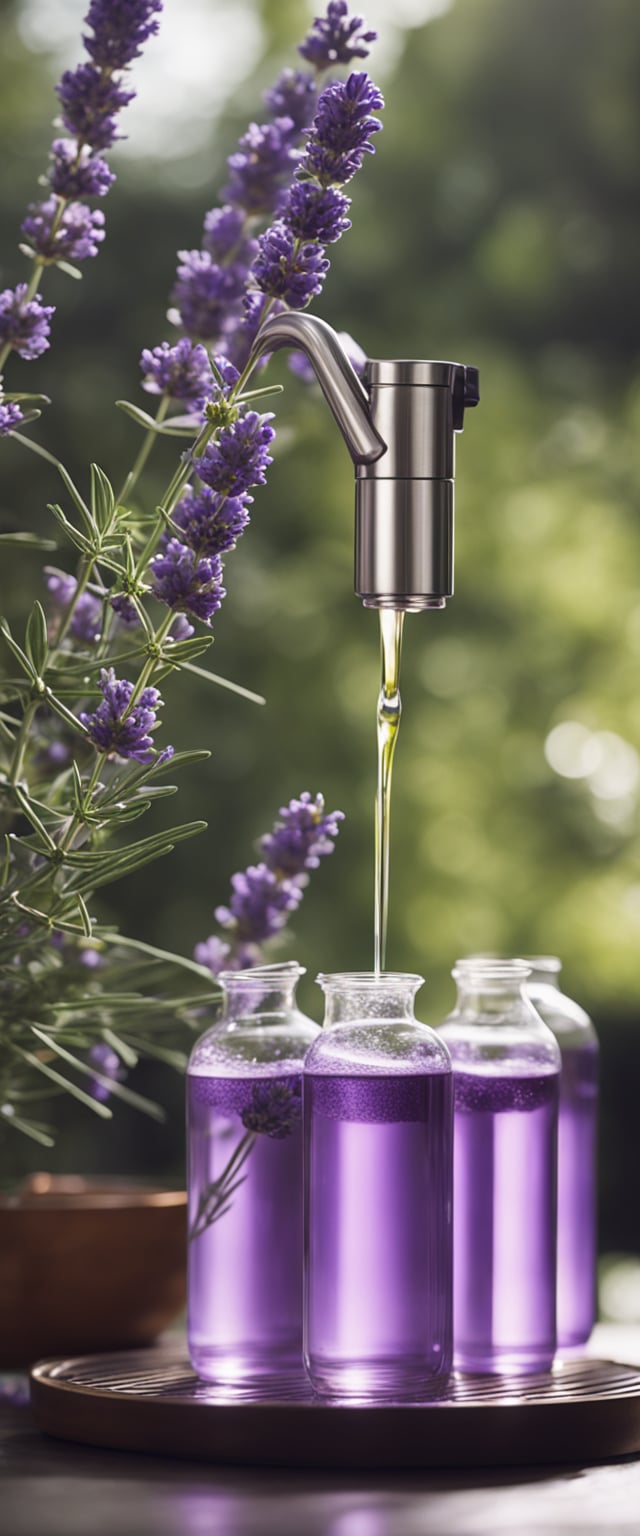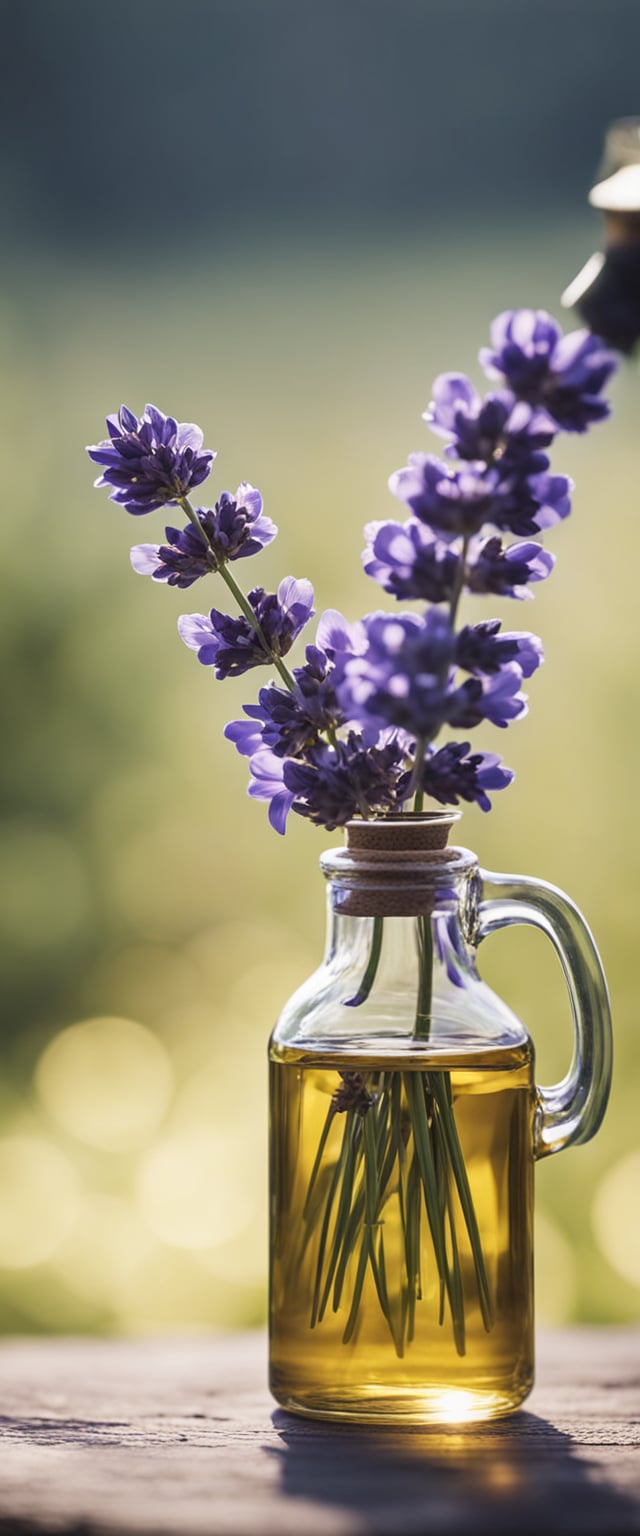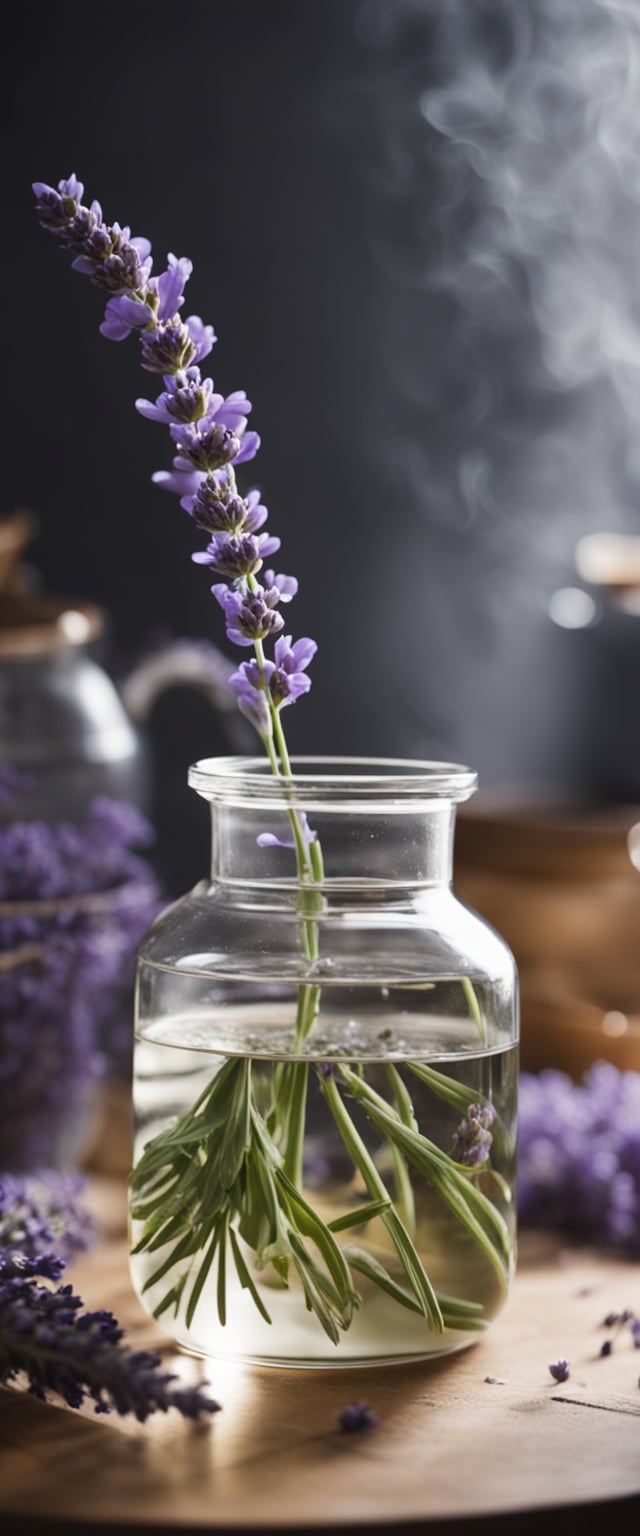Are you looking for a natural and cost-effective way to soothe your mind and body? Making your own lavender oil might be just what you need. Lavender oil is known for its calming and relaxing properties, making it a popular ingredient in aromatherapy and skincare products.
This post may contain affiliate links.
To make lavender oil, you will need fresh or dried lavender flowers, a carrier oil such as olive or almond oil, and a jar with a tight-fitting lid. The process involves infusing the carrier oil with the fragrance and benefits of lavender flowers.
Not only is this a fun and rewarding DIY project, but you’ll also have a high-quality lavender oil that you can use in a variety of ways.
Understanding Lavender Oil
In this section, we’ll explore the benefits of lavender oil and the different types of lavender that are used to create it.
Related Article: Types of Lavender: A Guide to Different Varieties
Benefits of Lavender Oil
Lavender oil has a wide range of benefits for both the mind and body. Here are some of the most common benefits:
- Promotes relaxation: Lavender oil is known for its calming properties and can help reduce anxiety and stress. It is often used in aromatherapy to promote relaxation and improve sleep quality.
- Relieves pain: Lavender oil has natural anti-inflammatory properties and can help reduce pain and inflammation caused by conditions like arthritis and muscle soreness.
- Improves skin health: Lavender oil has antibacterial and antioxidant properties that can help improve the overall health of your skin. It can also help reduce acne and other skin irritations.
- Enhances mood: Lavender oil has been shown to have mood-enhancing effects and can help reduce symptoms of depression and anxiety.
Related Article: Deadheading Lavender: A Guide to Promoting Blooms
Types of Lavender
There are several different types of lavender that are used to create lavender oil. Here are the most common types:
- English lavender: This is the most commonly used type of lavender for essential oil production. It has a sweet, floral scent and is known for its calming properties.
- French lavender: French lavender has a slightly different scent than English lavender and is often used in perfumes and other fragrances.
- Spanish lavender: Spanish lavender has a stronger scent than English lavender and is often used in aromatherapy blends.
The two main species of lavender used to make essential oil are Lavandula angustifolia (English lavender) and Lavandula x intermedia (a hybrid of English and spike lavender). English lavender is considered the highest quality for essential oil production.
Preparation for Making Lavender Oil

Choosing the Right Lavender
The first step in making lavender oil is to choose the right type of lavender. There are many different varieties of lavender, but not all of them are suitable for making oil.
The best type for making oil is English lavender, also known as Lavandula angustifolia. This type of lavender has a high concentration of essential oil and produces a high-quality oil.
When choosing your lavender, look for plants that are healthy and free from disease. Homegrown lavender is ideal, as it is free from pesticides and other chemicals. If you don’t have your own lavender, you can purchase dried lavender from Amazon.
Related Article: How to Grow Lavender from Cuttings
Harvesting and Drying Lavender
Once you have chosen your lavender, it’s time to harvest and dry it. The best time to harvest lavender is in the morning, after the dew has dried but before the sun is too hot. Cut the lavender stems just above the leaves, leaving about 6-8 inches of stem.
To dry the lavender, tie the stems together in small bundles and hang them upside down in a warm, dry, and sunny spot. Make sure the bundles are not too large, as this can cause the lavender to mold. It’s important to dry the lavender completely before using it to make oil.
Materials and Ingredients
Making lavender oil at home requires a few basic materials and ingredients that are easy to find. Here’s what you’ll need:
Selecting a Carrier Oil
The first step in making lavender oil is selecting a carrier oil. A carrier oil is a neutral oil that will dilute the lavender essential oil and make it safe to use. There are several carrier oils to choose from, including:
- Sweet almond oil: This oil is rich in vitamins and minerals and has a light texture that is easily absorbed by the skin.
- Jojoba oil: This oil is very similar to the natural oils produced by the skin and is ideal for people with oily or sensitive skin.
- Extra virgin olive oil: This oil is rich in antioxidants and has a strong aroma that may affect the scent of the final product.
- Safflower oil: This oil is high in linoleic acid and is ideal for people with acne-prone skin.
- Grapeseed oil: This oil is light and non-greasy and is easily absorbed by the skin.
- Apricot kernel oil: This oil is rich in vitamin E and has a light texture that is easily absorbed by the skin.
- Argan oil: This oil is rich in antioxidants and is ideal for people with dry or aging skin.
Additional Supplies
In addition to a carrier oil, you will need a few other supplies to make lavender oil at home. These include:
- Lavender flowers: You will need fresh or dried lavender flowers to infuse the oil.
- Glass jar: Use a glass jar with a tight-fitting lid to store the oil during the infusion process.
- Cheesecloth or muslin: You will need to strain the lavender flowers from the oil using a cheesecloth or muslin.
- Glass container: Once the oil is infused, store it in a dark glass container to protect it from light and heat.
Related Article: Lavender Simple Syrup Recipe
The Infusion Process

Making lavender oil involves infusing the lavender flowers in a carrier oil. This process is simple and can be done with just a few basic ingredients. Here are the steps to create the infusion.
Related Article: How Much Water Does Lavender Need: A Guide for Healthy Growth
Creating the Infusion
To make lavender-infused oil, you will need dried lavender flowers and a carrier oil. You can use any carrier oil such as olive oil, almond oil, or coconut oil. Here are the steps to create the infusion:
- Crush the dried lavender flowers slightly to release their fragrance.
- Add the crushed flowers to a clean, dry jar.
- Pour the carrier oil over the flowers until they are completely covered.
- Stir the mixture to ensure the flowers are evenly distributed.
- Seal the jar tightly and place it in a warm, sunny spot for a few weeks.
Infusion Time and Storage
The length of time you leave the lavender flowers in the carrier oil will depend on how strong you want the scent to be. Generally, you should leave the mixture to infuse for at least two weeks. However, you can leave it for up to six weeks for a stronger scent.
Once the infusion process is complete, strain the oil through a cheesecloth or fine mesh sieve to remove any solids. Store the lavender-infused oil in a clean, dry jar or bottle in a cool, dark place.
The oil should last for up to six months, but it’s important to check for any signs of spoilage such as a rancid smell or mold. If you notice any of these signs, discard the oil immediately.
Related Article: 7 Easy Lavender Recipes
Using Lavender Oil

Lavender oil is a versatile essential oil that can be used for a variety of purposes. Here are some of the ways you can use lavender oil:
Skincare and Beauty
Lavender oil has many benefits for the skin. It can be used as a moisturizer, as it helps to hydrate and nourish the skin. It can also be used to treat eczema and other skin conditions, as it has anti-inflammatory properties.
To use lavender oil as a moisturizer, mix a few drops with a carrier oil such as jojoba or almond oil. Apply the mixture to your skin and massage gently. You can also add a few drops to your bathwater for a relaxing and moisturizing soak.
Lavender oil can also be used to make a soothing salve or spray for the skin. To make a salve, melt beeswax and coconut oil in a double boiler, then add lavender oil and pour the mixture into a jar.
To make a lavender spray, mix lavender oil with distilled water and witch hazel in a spray bottle.
Related Article: Lavender Lemonade Kombucha
Therapeutic Uses
Lavender oil is known for its calming and relaxing properties. It can be used to relieve stress and anxiety, and promote a restful night’s sleep. Lavender oil can also be used to relieve pain and inflammation, and as a massage oil.
To use lavender oil for relaxation, add a few drops to a diffuser or inhale the scent directly from the bottle. To use lavender oil as a massage oil, mix a few drops with a carrier oil such as coconut or almond oil and massage into the skin.
Culinary Applications
Lavender oil can also be used in cooking and baking. It adds a unique flavor to dishes and can be used in both sweet and savory recipes. Lavender oil can also be used as an anti-fungal and immune system booster.
To use lavender oil in cooking, add a drop or two to your recipe. Lavender pairs well with lemon, honey, and vanilla flavors. You can also use lavender oil to make a soothing tea by adding a drop to hot water.
Safety and Precautions

When making lavender oil, it is important to keep safety and precautions in mind. Here are some things to consider:
Proper Usage and Dosage
Lavender oil is generally safe to use in small amounts and topically. However, it is important to dilute it properly before use. Using undiluted lavender oil can cause skin irritation or allergic reactions.
Related Article: Best Lavender Farms in Washington State
To make a safe and effective lavender oil, use a carrier oil such as vitamin E oil or witch hazel. You can also use a vitamin E capsule to add extra benefits to your lavender oil.
When using lavender oil, it is important to follow proper dosage guidelines. A general rule of thumb is to use a 2% dilution, which means adding 12 drops of lavender oil per 1 oz of carrier oil.
Potential Allergies and Interactions
Although lavender oil is generally safe to use, it can cause allergic reactions in some people. If you have a history of allergies, it is important to test the oil on a small patch of skin before using it.
Lavender oil can also interact with certain medications, such as those for mood disorders. If you are taking any medications, it is important to check with your doctor before using lavender oil.
Additionally, lavender oil contains camphor, linalool, and cineole, which can cause inflammation in some people. If you experience any redness, swelling, or itching after using lavender oil, stop using it immediately and consult a healthcare professional.
Preserving Lavender Oil

Maximizing Shelf Life
To maximize the shelf life of your lavender oil, you’ll want to store it properly. Here are some tips:
- Use a dark bottle: Light can cause essential oils to degrade, so it’s best to store your lavender oil in a dark bottle. Amber or blue glass bottles are good choices.
- Keep it cool: Heat can also cause essential oils to degrade, so store your lavender oil in a cool place, away from direct sunlight.
- Check the expiry date: Essential oils do have an expiry date, so make sure to check the date on your lavender oil. If it’s expired, it’s best to dispose of it.
Storing Tips
In addition to the tips above, there are some other things you can do to help preserve your lavender oil:
- Use organic lavender: Using organic lavender to make your oil can help ensure that there are no harmful chemicals or pesticides in your oil.
- Use sachets: If you don’t want to use your lavender oil right away, you can make sachets with dried lavender flowers. These sachets can be placed in drawers or closets to add a pleasant, aromatic scent.
- Use a pestle and mortar: If you’re making your own lavender oil, using a pestle and mortar to crush the lavender flowers can help release the oils and create a more potent oil.
Frequently Asked Questions

What is the process for creating homemade lavender oil using fresh lavender?
To make lavender oil using fresh lavender, you will need to first harvest the lavender flowers and let them dry for a few days.
Once they are dry, you can crush them and put them in a jar with a carrier oil, such as olive oil or almond oil. Let the mixture sit in a warm, sunny place for a few weeks, shaking the jar every few days.
After a few weeks, strain the mixture through a cheesecloth and store the oil in a dark glass bottle.
What’s the method for crafting lavender oil that can be used in candle making?
To make lavender oil for candle making, you will need to use a wax-compatible carrier oil, such as soybean oil or beeswax. Add dried lavender flowers to the carrier oil and heat the mixture in a double boiler for a few hours.
Strain the mixture through a cheesecloth and let it cool. Once the oil has cooled, it can be added to melted wax to create a lavender-scented candle.
Which carrier oils, like coconut oil, are best for making lavender oil, and what’s the process?
There are many carrier oils that can be used to make lavender oil, including coconut oil, olive oil, and almond oil. The process for making lavender oil using a carrier oil is the same as making homemade lavender oil using fresh lavender.
Simply crush the lavender flowers and add them to the carrier oil, then let the mixture sit in a warm, sunny place for a few weeks. Strain the mixture through a cheesecloth and store the oil in a dark glass bottle.
Follow my lavender board on Pinterest.




